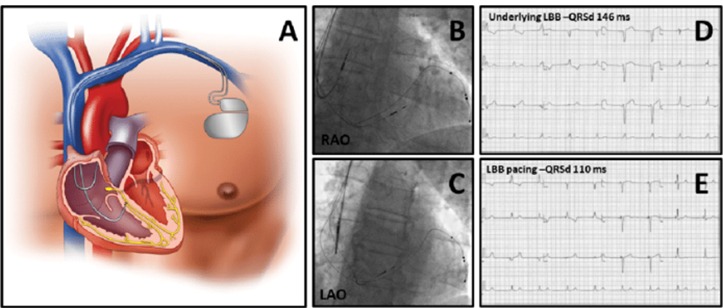LEFT BUNDLE PACING
Left bundle branch pacing (LBBP) is a relatively new technique used in cardiac pacing to treat various heart rhythm disorders, such as bradycardia or heart failure. Traditionally, pacing has been achieved by stimulating the right ventricle or right atrium. However, research has shown that pacing the left bundle branch (LBB) can offer more physiological activation of the heart’s electrical system.
Here’s a brief overview of how LBBP works:
- Anatomy of the Bundle Branches: The bundle branches are part of the heart’s electrical conduction system. The left bundle branch divides into two main branches, the left anterior fascicle and the left posterior fascicle. These branches help conduct electrical impulses to the left ventricle, allowing it to contract effectively.
- Pacing Technique: During LBBP, a lead (a small, insulated wire) is positioned in or near the left bundle branch. This lead is connected to a pacemaker or defibrillator device, which delivers electrical impulses to stimulate the heart. By pacing the left bundle branch, the electrical signal more closely mimics the heart’s natural conduction pathway.
- Advantages: LBBP offers several potential advantages over traditional pacing methods:
- Physiological Activation: By pacing the left bundle branch, the heart’s natural conduction system is more closely replicated, potentially leading to more efficient and synchronized heartbeats.
- Improved Cardiac Function: Some studies suggest that LBBP may improve cardiac function and reduce the risk of developing heart failure.
- Reduction in Pacing Induced Cardiomyopathy: Pacing from the left bundle branch may reduce the risk of developing pacing-induced cardiomyopathy, a condition where long-term pacing can weaken the heart muscle.
- Challenges and Considerations: While LBBP shows promise, there are also challenges associated with the technique:
- Technical Complexity: Placing a lead in the left bundle branch requires expertise and precise positioning.
- Potential for Complications: As with any cardiac procedure, there is a risk of complications such as lead dislodgement, perforation, or infection.
In summary, left bundle branch pacing represents an innovative approach to cardiac pacing that aims to provide more physiological stimulation of the heart. While further research is needed, initial studies suggest that LBBP may offer advantages in terms of cardiac function and clinical outcomes for certain patients.
